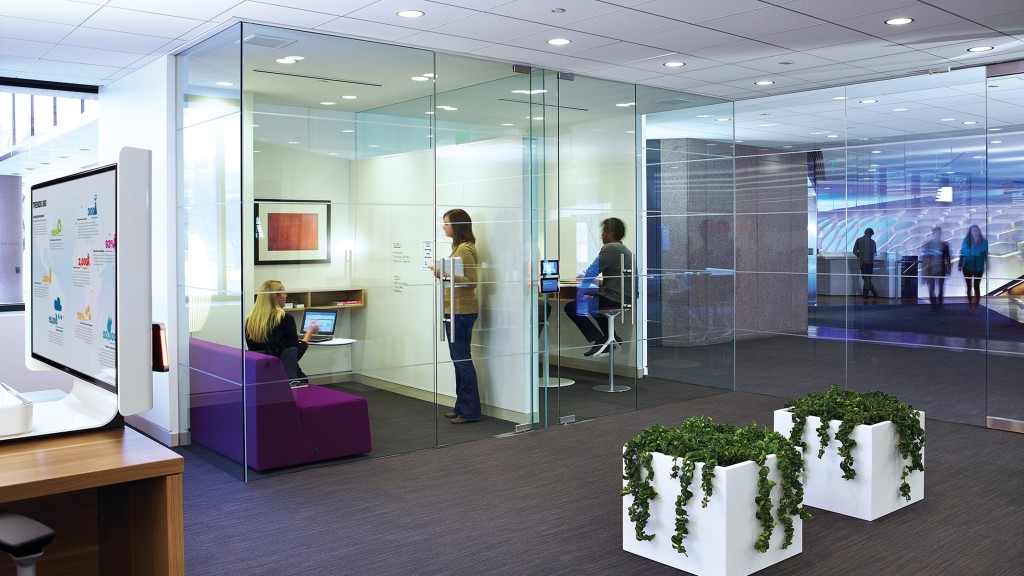The Privacy Paradigm
As the researchers synthesized their work, it became clear that supporting people’s privacy needs in the workplace requires a diversity of environments.
“There’s a tendency to think about privacy primarily in terms of the private office. This paradigm has been embedded in workplace design,” says Flynn. “Our research confirmed that people seek privacy for various reasons and they want it for a variety of timeframes. Sometimes it might mean finding a place to sit down and focus for an hour, sometimes it might mean just being quiet for 20 minutes between crazy meetings to calm the mind and still your thoughts. We see opportunities to reinvent private spaces within the entire workplace landscape, to offer spaces that can be very personal and personalized for someone when they need it. Having choices and some control over your experiences at work is really key for people’s wellbeing and performance.”
“Privacy isn’t always about four walls and a door,” says Redman. “You can have a measure of privacy with two walls, you can have privacy in open spaces. It depends on what kind of experience you’re looking for. ”
Even if not enclosed, informal settings that attend to human needs in obvious ways can feel more private than impersonal, institutional environments. Something as simple as high-back lounge seating can envelope a person in a semi-private cocoon.
For most workers, privacy needs ebb and flow throughout the day as they toggle between collaboration and tasks that require shallow individual focus, such as routine emailing, and those that require deep individual focus, such as analyzing data or creating something new. Mihaly Csikszentmihaly is prominent among psychologists who say humans are wired to seek deep absorption in complex challenges, achieving a state of consciousness that he described as flow. Of course, for individuals and teams, privacy alone can’t ensure flow, but the lack of privacy can obviously prevent it.
As much as people are wired for individual achievement, they’re also wired to crave collaboration. Working in privacy all the time can have as many negative impacts on performance as always working in collaboration, and also carries as many health risks as smoking, says David Rock.
“What’s been overlooked in the push for collaborative work is the value of individual time.”
DONNA FLYNN
Social interactions are a delicious thing to the brain…,” he explains. “Your brain loves interaction with people, it’s a very important part of keeping ourselves alive.”
Because our brains are deeply social, if someone walks past our desk, we can’t help but look up, he notes. “It’s a knee-jerk reaction. So whether it’s someone walking past your desk or someone sending you an email, these distractions are much too powerful to avoid. So we need to create time and space to switch these things off and do deeper thinking… If we talk about pure collaboration, we see it’s actually about being able to come together and make thinking visible, and also being able to go away and do quiet work and then come back together. So the opportunity is to be able to reflect and then regroup, reflect and regroup.”

Because human needs for privacy and togetherness are yin and yang —essentially different but also complementarily linked —there is no single type of optimal workspace.
“What’s been overlooked in the push for collaborative work is the value of individual time in contributing to the collaborative effort,” says Flynn. “The value of collaborative work isn’t going away. Our research has shown that when you have diverse minds coming together to solve a problem, you tend to solve that problem with a higher-quality solution. But we need to recognize that collaboration 8-10 hours a day is going to lead to burnout. The way to support people is to provide the ability to move between individual time and collaborative time, having that rhythm between coming together to think about a problem and then going away to let those ideas gestate. That’s a really important, basic human rhythm.”
“We need to find the balance between the two ends of the spectrum,” she continues. “The future is really in that balance because people are going to continue to be mobile, people are going to continue to be augmented by technology and that’s going to drive the need for even more individual choice-making across the spectrum.”
Company Informations:
Le Office Furniture Manufacturer
www.letbackrest.com
Address: No.12, Nanhua Road, LongJiang ,Shunde,Foshan, Guangdong, China (Mainland)
Email: sale@letbackrest.com
skype: kinmai2008

